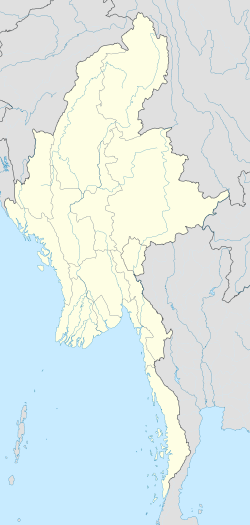Pahtodawgyi
In the world of Pahtodawgyi, there is a wide range of opinions, studies and research that allow us to enter a universe full of possibilities and discoveries. From its origins to the present, Pahtodawgyi has sparked the interest and curiosity of experts and hobbyists alike. In this article, we will explore the various aspects that make Pahtodawgyi a fascinating and relevant topic today. From its impact on society to its influence in different areas of daily life, we will immerse ourselves in a fascinating journey to understand its importance and relevance in the modern world.
| Pahtodawgyi | |
|---|---|
ပုထိုးတော်ကြီး | |
 | |
| Religion | |
| Affiliation | Theravada Buddhism |
| Location | |
| Location | Amarapura, Mandalay Region, Burma |
| Geographic coordinates | 21°54′41″N 96°03′23″E / 21.911432°N 96.056438°E |
| Architecture | |
| Founder | King Bagyidaw |
| Date established | 1819 |
Pahtodawgyi (Burmese: ပုထိုးတော်ကြီး) is a Buddhist pagoda located in Amarapura, Burma, north of the Taungthaman Lake.[1] It was built in 1819 by King Bagyidaw.[1]
History
On 10 April 1819, King Bagyidaw built the pagoda and enshrined the sacred relics of the Buddha, along with numerous Buddha statues cast in pure gold. The pagoda stands at an impressive height of 120 taung (approximately 27 meters or 88.5 feet).
On 22 March 1839, a powerful earthquake struck Sagaing with devastating force, causing the sacred hti (ornamental crown) of the pagoda to collapse. Following the disaster, the pagoda remained without its hti for 34 years. This absence lasted until 1872, when King Mindon ordered the installation of a new hti. The replacement crown stood 13 taung and 1 twa tall (approximately 7.9 meters or 26 feet), with a circumference of 9 taung and 2 maik (about 5.5 meters or 18 feet). The project was supervised by the Popa wun, the governor of the Popa region.
The hti donated by King Mindon also collapsed due to an earthquake in 1912 (Myanmar Era 1274). As a result, the pagoda remained without hti for seven years. It was not until 1919 (Myanmar Era 1281), seven years later, that the residents of Amarapura donated and installed a new hti. However, this hti was again damaged during the earthquake of July 1956.[2]
The pagoda was again damaged during the 2025 Myanmar earthquake.[3]
Notes
- ^ a b Mandalay 1910, p. 20.
- ^ "ကုန်းဘောင်ခေတ် ပုထိုးတော်ကြီး နှစ်ဆူ". MOI Webportal Myanmar.
- ^ "အင်အားကြီးငလျင်ကြောင့် မဟာမြတ်မုနိဘုရားကြီး အပါအဝင် ရှေးဟောင်းစေတီ၊ အဆောက်အဦး (၆၀) ကျော် ထိခိုက်ပျက်စီး". NP News.
References
- List of Ancient Monuments in Burma (I. Mandalay Division). Vol. 1. Rangoon: Office of the Superintendent, Government Printing, Burma. 1910.
